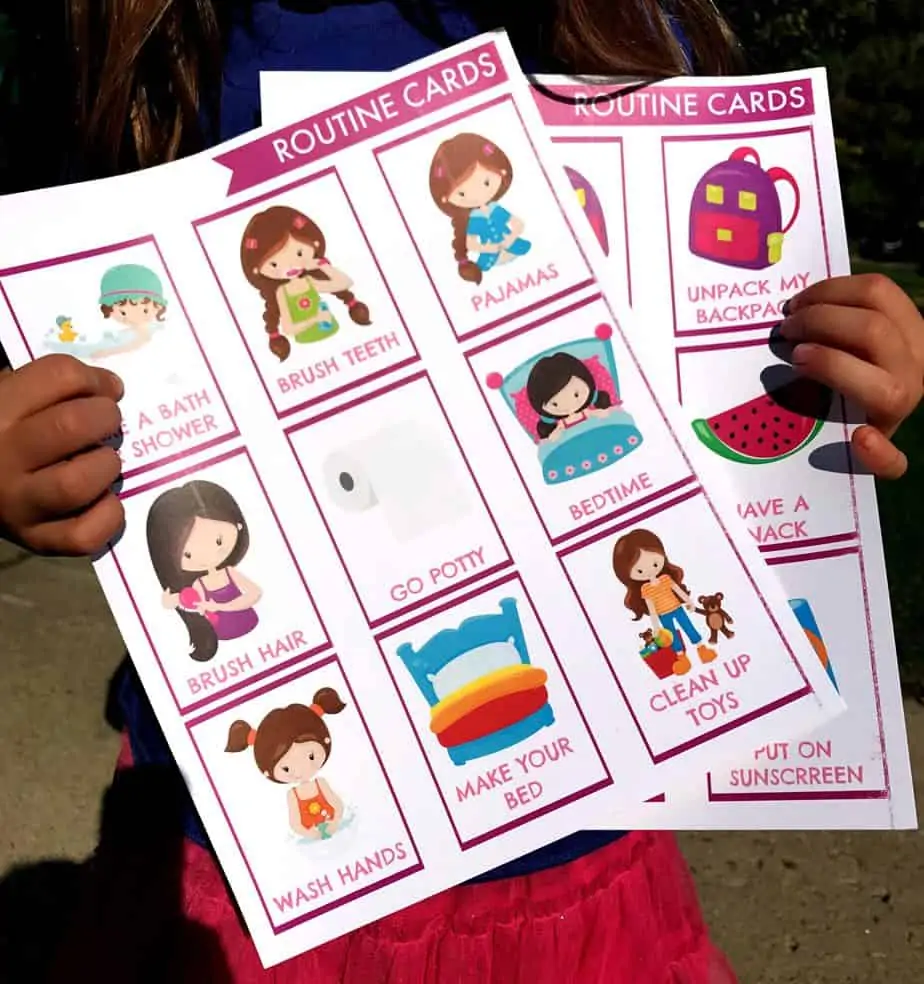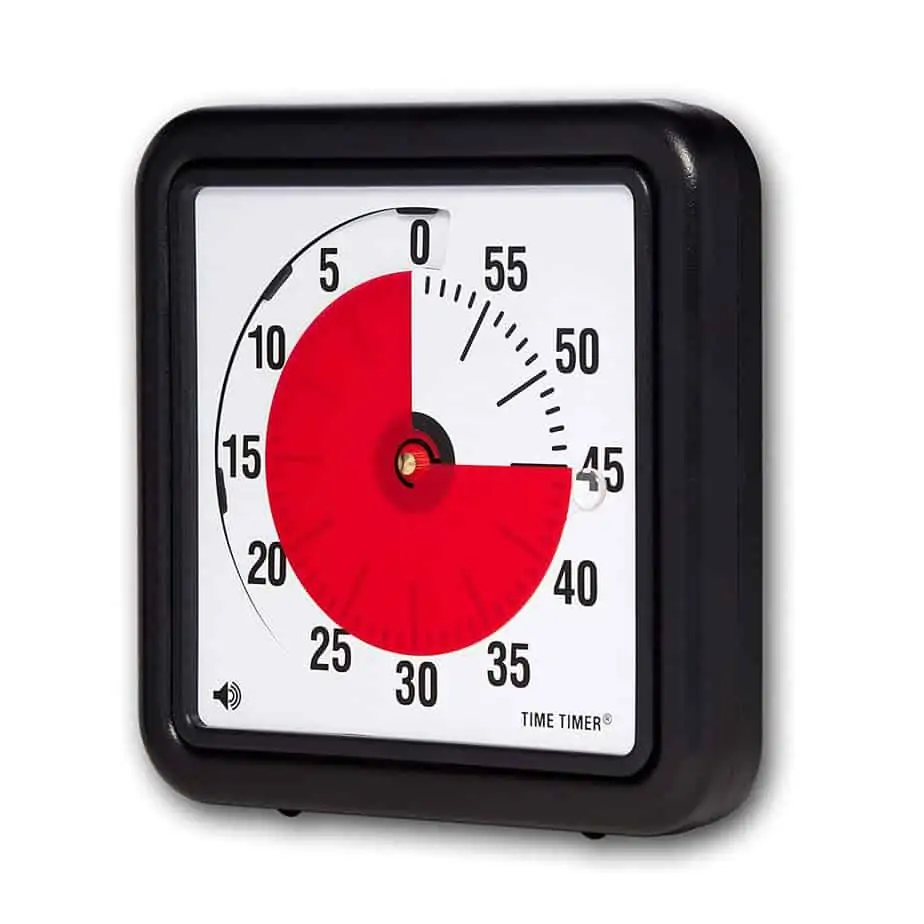The surprisingly reason why power struggles happen at bedtime (and the surprisingly simple fix) and 7 ways to help perfect your child’s bedtime routine. Plus, how to incorporate picture routine cards for a smoother pre-bedtime routine.
Tips for Perfecting Your Child’s Bedtime Routine
After a long day of parenting, you quietly shut your child’s door and tip toe towards your little slice of heaven.. the couch and binge watching your favorite Netflix show.
All that stands in between you and quiet adult time, are the little ones who’ve got you crossing your fingers, are now peacefully drifting off to sleep.
What could go wrong?
The truth is, in the next 10 minutes, you’ll probably be up and down, and back and forth into their bedrooms bringing a glass of water, rubbing his back, giving 10 more sweet kisses, and a 2-minute cuddle which likely will turn into 30.
If you’re lucky, this routine will only take 10 more minutes of your time, but could also take a full hour if all hell breaks loose.
“I’m not tired.”
“I need more water.”
“Will you cuddle with me Mom?”
“Can you read me one more book?”
“Mom, I have a question.”
“I just want to talk…”
The dance is sweet for about 30 seconds, then it’s not.at.all.
The truth is, bedtime battles are a form of power struggles.
If all behavior tells us something as it does, then it’s our job as parents to decipher what power struggles at bedtime are trying to tell us.
There are several reasons why bedtime power struggles happen, that you’ll need to fix before you can master your bedtime routine.
What are those reasons why bedtime power struggles exist so we can get to the good stuff of perfecting our child’s bedtime routine, because my crystal ball says what you really want is more sleep in your house.
The Most Common Reason Why Power Struggles Happen at Bedtime
Your Child Craves More Connection with YOU
When a child’s attention bucket isn’t full, they’ll ask for your attention in unwelcome ways, and often at bedtime when there are no other distractions for your attention.
Children thrive on feeling significant and important and want to feel like they matter to their parents. Asking for water, for a hug, more snuggles or an extra blanket is a way for them to ask you to care for them and give them love and attention.
I try to get 10-20 minutes of one-on-one time with each of my kids daily so I can fill their love bucket. I also aim to be consistent about when they get it, so we both know it’s coming and can look forward to it.
Here’s what we do at our house:
- For my oldest daughter, this may be our nightly “talk time” when we make dinner or go on a walk together after dinner. Sometimes she’ll also come downstairs early before everyone else in the mornings to “hang out” and I know it’s a sign she needs more time alone with me.
- My son likes to play catch or build things together after school. This is a time for him to decompress and get connection with me after a day of us being apart.
- and my youngest daughter loves to snuggle up on the couch or bed and read books together during her pre-bedtime routine.
This time is something we all look forward to together and I notice when we don’t get it in, which child needs more time to connect.
When you provide this dose of positive attention, you’ll reduce attention-seeking behavior at bedtime like whining, dragging things out with endless requests, and fighting sleep.
How to Create a Better Bedtime Routine
1 – Consistency Requires Same, Same, Same to Set up a Bedtime Routine
For bedtime to work, there’s nothing more important than to stick with a routine you do at the same time, in the same way, and in the same place each night.
I know routine isn’t for everyone, and nights can get crazy with dinner, school activities, sports, and last-minute projects, but if you want bedtime to go down without a problem, this is one of those important things you can’t budge on.
Routine can be a lifesaver. Especially if you want to have your own time after the kids are asleep or watch your Netflix shows.
If you don’t already have a routine, this is the first step in combating bedtime battles.
- Step 1: Set a reasonable bedtime that is the same time every night of the week (even on the weekends.) A reliable schedule is what helps your body’s natural circadian rhythm tell you when the body is ready to fall asleep.
- Step 2: Stay consistent. Even when you child begs to stay up, or finish a movie, the less you budge when it comes to bedtime, the more they’ll learn they can’t negotiate and their bedtime is the same each night.
- Step 3: Create a routine with the same steps you follow each night. This may be taking a bath, getting in pajamas, brush teeth and hair, read a book and then it’s lights out.
When kids stay up too late or are overtired at bedtime, is when you can see an uptick in fears around bedtime. It’s important to be an age-appropriate bedtime based on if your child is still napping or not, and their activity levels. This bedtime sleep chart can help guide you to choose a bedtime.
2 – Set up a good Pre-Bedtime Routine
A good bedtime routine will take between 20 – 30 minutes, or a little longer if you include a bath or shower.
As your child gets older, their bedtime routine will change over time.
Here’s a sample pre-bedtime routine for a toddler/preschoolers:
- Take a bath or shower
- Get into pajamas
- Brush hair
- Get a cup of water
- Brush teeth
- Read two books with Mom or Dad
- Lights out
Here’s a sample pre-bedtime routine for an older child/tween:
- Take a shower
- Get into pajamas
- Brush hair and teeth
- Read until 9pm or play a board game with siblings / parents
- Lights out at 9pm
3 – Give Kids Time to Get the Hang of the Routine
It’ll take some time for your children to get the hang of your new bedtime routine. Learning the order of operation won’t click overnight, so it’s important to be patient and allow for a learning curve to happen, especially for toddlers.
Using picture routine cards can be a huge help showing kids the steps for your bedtime routine. Or a chart, such as a bedtime routine chart that visually shows kids the order for the night can work great too!
Older kids will pick up things quicker, but still need a few days or a full week to get the hang of your new routine and bedtime.
4 – “When- Then” Rules Before Bedtime
Anytime you create a new routine or set new rules, kids will want to rebel. They’ll reject boundaries, try to go out of order and see how far they can push limits.
I learned about the When- Then rules from Amy McCready, author and founder of Positive Parenting Solutions.
She says, “This tool helps motivate kids to complete the more mundane parts of their bedtime routine they may dislike.”
For example, when we say, “Trenton, when you brush your teeth, then we can read a book.”
She says children are ultimately in control of when they’ll complete these tasks, and if they complete them quickly they get to do the things they enjoy afterwards like reading a book, or cuddling with Mom or Dad before the lights go out.
However, if they don’t move quickly, then it’s entirely up to them if they don’t get to the “then” piece of the night before it’s bedtime.
The thing is, you have to be consistent. If your child doesn’t get to do the extra thing before bedtime, then they go to bed and the next day, they’ll learn they have to move quicker to get the “when-then” part of the night.
When children know what to expect each night, they’re more likely to comply.
If your children are still getting the hang of feeling out how time works, something like a Time Timer (shown on the right) that works as a visual showing kids how much time is left, can be a huge help.
This countdown method works so much better than shouting, “2 more minutes!”
5 – Don’t Energize Kids at Night
My husband will go on work trips for a week at a time and when he gets home, he’ll break this rule of not winding the kids up before bedtime. Guess who has to deal with them when they bounce in and out of their beds or won’t fall asleep at their normal time? Him.
While it’s fun to have a pillow fight or hide-and-seek from the dogs now and again, doing it right before bed is like shaking a can of soda and waiting for it to explode.
The same is true with kids, when you wind them up and do energizing activities before bedtime, their bodies no longer think it’s time to go to sleep, but to stay up and have fun!
If you do energizing activities, make sure they’re at least an hour before bedtime and you have plenty of calm ones to do afterwards to help kids slow down and prepare for bed.
Also, avoid caffeinated drinks and food which can stimulate kids just like pillow fights and wrestling games.
6 – Limit Technology Use at Night
The CDC says, “Bright evening light 2 hours before bedtime will shift the time for sleep later, so you will tend to get sleepy and fall asleep later in the evening.”
From Tox Free Family on how to get better sleep and synch your circadian rhythms with day and nighttime light;
Aside from soaking in your morning sun and schedule sunshine breaks throughout the day, there are a few extra steps you can take in the evening to prepare your body for sleep.
- Avoid Blue Light After Sundown.
This is exposure through screens, devices, television and of course your phone. You can add blue screen blockers and use apps (like flux.com) to your computer, however the best way to continue with your norming viewing without affecting your sleep is to use blue blocker glasses to block out your blue light exposure.
- Change lightbulbs to Block the Blue Light.
You can switch all your lights off at night so you don’t have any light exposure, use blue light blocking lightbulbs or switch your bedroom, bathroom and rooms you use most at night to red light bulbs.
Read all the tips from Tox Free Family for setting the mood for a good night’s sleep (for kids and adults!)
7 – When Children’s Anxieties Pick Up At Night
Anxiety has a sneaky way of showing up when things get quiet at night once your child has crawled into bed.
Children’s anxieties different from adults, and while they can seem irrational to adults, they’re very real and terrifying to them. Whether it’s monsters hiding in the closet, dark shadows in the corners, future catastrophes at school or fallout with friends, it’s good to approach anxiety with tender love and empathy to bolster your child’s sense of security.
A sense of security can be helped along through quality connection and communication right before bedtime. A quiet, calming sense of happiness and safety will lead to good sleep.
We live to use the 5 Senses Grounding Technique when anxiety pops up. (grab the free printable in the article too!)
More Thoughts on Creating the Perfect Bedtime Routine
If you’ve made it this far, I’m going to guess bedtime at your house hasn’t been the easiest part of your day. Starting tonight, give these strategies a try. Don’t forget, new routines take time to adjust to so don’t give up if you don’t see improvement by tomorrow.
Implementing a good bedtime routine will help you avoid bedtime power struggles and bring more sleep into your lives – something we could all do with more of.
Want even more?
Shop All Parenting Resources
Shop all of our parenting resources from self-regulation tools and managing big emotions to building self esteem and confidence. There are resources for all seasons of life!











